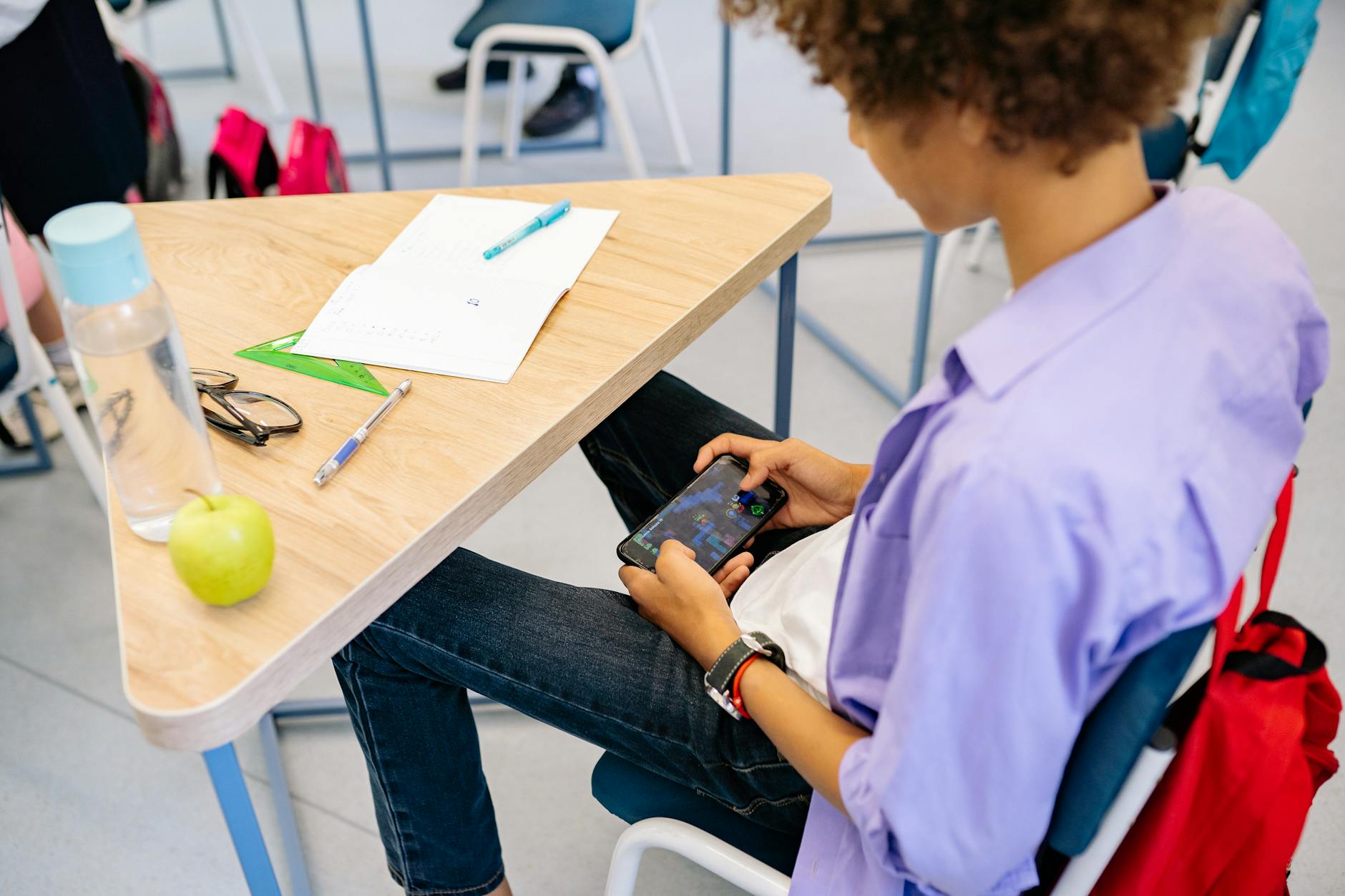This post contains affiliate links. If you purchase through these links, I may earn a commission at no extra cost to you. As an affiliate, I earn from qualifying purchases.
Technology is everywhere, and kids are quick to adapt to it. Educational apps are becoming an essential part of learning, offering fun and interactive ways to build study habits. With the right tools, children can improve skills like reading, math, and problem-solving—all while staying engaged. But the real value lies in choosing apps that foster active learning and meaningful interaction rather than distractions. In today’s tech-driven world, these apps provide a smart, accessible solution for supporting kids’ success in school and beyond.
The Importance of Building Study Habits Early
Strong study habits are not only about getting better grades—they teach kids the discipline and structure they’ll rely on for years to come. By starting early, parents and educators can give children the tools they need to thrive academically and personally.
How Early Habits Impact Long-Term Success
Did you know that habits formed during childhood often stick with us for life? Research has shown a direct link between early study habits and long-term academic success. According to Mackler Advantage, children who practice consistent study routines perform better in school and develop essential skills like time management and self-motivation. These same skills prove invaluable in adulthood when juggling work, family, and personal responsibilities.
Early study practices also foster a sense of accountability. For example, learning to plan for daily homework assignments can lay the groundwork for effectively balancing bigger projects later on, such as a high school science fair or even a corporate deadline. Think of it as planting small seeds that grow into strong, reliable trees over time.
But the benefits go beyond academics. When kids understand how to break tasks into smaller, manageable chunks, they’re more likely to face challenges head-on instead of avoiding them. This mindset creates resilience, an important life skill for any career or personal goal.
Challenges in Developing Study Habits in Kids
It’s no secret that building study habits isn’t always smooth sailing. Children—and parents—face a variety of challenges along the way. A few common hurdles include:
- Limited Attention Span: Let’s face it, most kids struggle to focus on tasks for extended periods. That’s why it’s crucial to adjust study activities to be age-appropriate and engaging.
- Lack of Motivation: Not every child will be naturally excited about learning. Developing habits often requires finding what sparks their interest, whether it’s a favorite subject or rewarding milestones.
- Inconsistent Routines: Busy family schedules can make sticking to a study plan tough. Without a regular structure, kids may find it harder to form lasting habits.
As noted in Metro Family Magazine, steps like creating a designated study space and limiting distractions can go a long way. A clutter-free area combined with clear goals allows kids to stay on track without feeling overwhelmed.
Parents play a crucial role here. By modeling good study behaviors—like sitting down to read alongside kids or organizing a calendar for family activities—they inspire children to do the same.

Photo by RDNE Stock project
Addressing these challenges may take time, but with persistence and the right tools, children can build a foundation that lasts a lifetime.
How Educational Apps Can Support Study Habits
Educational apps aren’t just about convenience; they’re reshaping how kids learn and making study routines more effective. These digital tools combine fun, functionality, and personalization to help children build sustainable habits. From gamified lessons to detailed progress reports, apps offer a toolbox of features that cater to varying needs and keep learning exciting.
Interactive Learning for Engagement

Photo by Yan Krukau
Capturing a child’s attention is no easy task, but educational apps rise to the challenge by incorporating gamification and multimedia tools. Imagine a vocabulary lesson turned into a quest where kids earn rewards for every correct answer—it feels more like a game than a chore. Interactive features such as animations, quizzes, and digital badges keep young learners motivated and committed.
According to Orient Software, this level of engagement helps children process and retain information more effectively than traditional methods. When learning feels fun and hands-on, kids are more likely to look forward to study time.
Personalized Learning Experiences
Every child learns differently—some absorb material quickly, while others benefit from a slower pace. Educational apps address these differences by offering customized learning pathways. Features like adaptive quizzes and progress tracking adjust difficulty levels in real-time, ensuring children aren’t overwhelmed or bored.
For example, if a child struggles with multiplication, the app can provide additional exercises tailored to their needs. This tailored approach boosts confidence and allows for deeper understanding, which is often missed in traditional classroom settings. Platforms that offer personalized tools empower children to take ownership of their learning journey while staying aligned with their unique abilities.
Tracking Progress and Encouraging Accountability
Monitoring progress is critical for both kids and parents. Many educational apps include built-in analytics features that provide valuable insights into a child’s achievements, challenges, and study habits. Data points such as time spent on tasks, quiz scores, and completed milestones give parents and educators a clear picture of performance.
Parents can use this information as an opportunity to set realistic goals and celebrate small wins, which keeps motivation high. It’s like having a digital accountability buddy that encourages discipline without micromanaging. Furthermore, apps like this make it easier to spot gaps early, offering a chance to intervene before they become larger issues. Resources like this guide on ten successful online study habits highlight how consistent tracking can make a world of difference.
Benefits of Gamification in Study Apps
Gamification isn’t just a buzzword—it’s a powerful way to make learning stick. By turning lessons into challenges and incorporating rewards like badges and leaderboards, apps tap into children’s natural love for games. These elements foster a sense of achievement and progress, motivating kids to stay on top of their studies.
According to Edutopia, gamification makes learning feel less like work and more like an adventure, leading to higher engagement and improved retention. Think about it: a child working hard to “level up” in a reading app may not even realize they’re mastering essential vocabulary skills along the way.
Studies have also shown that playful learning reduces stress and anxiety, making it easier for kids to tackle challenging subjects. Plus, the competitive elements can inspire friendly rivalry among peers, fostering collaboration and teamwork.
Choosing the Right Educational Apps
Not all educational apps are created equal. Some help kids thrive, while others can hinder progress. Choosing the right app involves more than just downloading a popular name. It’s about ensuring the app aligns with educational goals, fits a child’s developmental stage, and minimizes distractions. Let’s explore how to evaluate and select effective apps that truly enhance learning.
Evaluating Apps Based on Learning Science
Educational apps should go beyond flashy graphics—consider how they promote real learning. Experts emphasize three key criteria rooted in educational science:
Active Learning: Does the app encourage children to think critically, solve problems, or construct new knowledge? Apps that require interaction—like answering questions or solving puzzles—foster active engagement, unlike passive watching or clicking.
Meaningful Engagement: Look for apps that spark curiosity and keep kids coming back for more. For instance, a dynamic math game might connect numbers to real-life scenarios rather than focusing solely on repetition.
Social Interaction: Apps that integrate collaborative elements—like allowing children to work alongside a parent or classmate—can strengthen learning. Studies suggest that social connections boost motivation and understanding.
To dive deeper into these factors, check out resources like ISTE’s guide on evaluating educational apps, which breaks down practical methods for assessing an app’s value.

Photo by MART PRODUCTION
Age-Appropriate and Curriculum-Linked Apps
Does the app suit your child’s age and academic level? This is crucial. Apps designed for younger kids often feature simpler tasks with colorful visuals, while those for older children may incorporate deeper, multi-step activities.
Here are tips to ensure a perfect match:
Check Developmental Relevance: An app aimed at teaching phonics to preschoolers won’t be helpful for fifth graders tackling fractions. Apps that match a child’s developmental stage are more likely to be engaging and effective.
Align with School Curriculum: If your child is struggling with multiplication or spelling, look for apps built around those specific needs. For instance, apps like Reading Eggs & Mathseeds offer tools tailored to core academic subjects, helping bridge gaps in schoolwork.
Balance Learning and Fun: Apps that tie lessons to entertaining challenges or rewards are less likely to bore kids. It’s all about finding tools that teach while keeping engagement high.
By taking time to analyze these factors, you’ll find apps that support—not replace—your child’s classroom experience.
Avoiding Apps with Distractions
Many apps promise education but fall short when loaded with unnecessary distractions. Excessive ads, irrelevant pop-ups, or flashy animations can break a child’s focus, turning study time into frustration.
To steer clear of these pitfalls:
Say No to Over-Advertising: Apps that feature constant interruptions or push in-app purchases disrupt concentration. Opt for ad-free educational tools or premium versions when feasible.
Avoid Overloaded Graphics: An app doesn’t need to look like a carnival to be effective. Too many animations or sounds can pull attention away from learning objectives.
Watch for Irrelevant Games: Many apps sneak in unrelated mini-games that derail study sessions. Stick to apps with features and activities directly tied to learning goals.
By choosing wisely, you’ll create a focused digital environment where children can thrive without unnecessary distractions. A detailed guide like this one from the NAEYC might help simplify the process.
Selecting the right educational app today can ignite a lifetime of learning. When apps offer structured, meaningful, and age-appropriate content, they become valuable tools in building better study habits for kids. Keep these tips in mind the next time you’re scrolling through the app store—your child’s future study sessions will thank you!
Tips for Families Using Educational Apps at Home
Helping your kids make the most out of educational apps doesn’t have to be complicated. With the right strategies, these tools can seamlessly support study habits while promoting skills like time management and self-motivation. Below are some practical tips to keep in mind as a parent.
Creating a Balanced Screen-Time Routine

Photo by Helena Lopes
Screen time can be a double-edged sword—it’s both a learning opportunity and a potential distraction. To ensure it remains beneficial, focus on balance.
- Set Time Limits: Establish daily or weekly limits for app-based learning. For example, 45 minutes of focused app use followed by outdoor play lets kids recharge while staying engaged.
- Incorporate Breaks: Encourage movement breaks between sessions. A five-minute stretch or snack can help maintain concentration.
- Diversify Activities: Blend screen-based learning with offline activities. For instance, complement a reading app with family story time or hands-on crafts to apply what they’ve learned.
Striking this balance not only encourages discipline but also supports their mental and physical well-being. For more helpful strategies, explore this guide to managing home learning.
Co-Viewing and Parent Engagement
Kids thrive when learning isn’t a solo journey. By co-viewing or participating in app-based activities, you create shared experiences and enrich their understanding.
- Engage in Conversations: Ask questions while your child uses the app, like, “What did you just learn?” or “How can we use this in real life?”
- Do Activities Together: Some apps are designed for collaboration; explore features that let you join in as they learn.
- Tie Lessons to Everyday Life: Use real-world examples to reinforce app concepts. If they’re learning about fractions, involve them in measuring ingredients while cooking.
Parental involvement bridges the gap between virtual learning and practical application, ensuring the knowledge sticks. Research confirms this approach exponentially increases learning outcomes, as found in this study about effective tools for families.
Setting Goals and Rewards
Motivation can waver, but with clear goals and celebrated wins, kids stay on track.
- Define Clear Objectives: Start with small, tangible goals like completing a set of math exercises or mastering three new vocabulary words.
- Introduce Rewards: Celebrate milestones with rewards—stickers, an extra 10 minutes of screen-free playtime, or even verbal praise.
- Track Progress: Use apps with built-in analytics to monitor accomplishments and challenges. Show your child how much they’ve improved to keep them motivated.
Reward systems help children associate effort with achievement, turning learning into a positive experience. Want more ideas? Dive into this article on designing meaningful educational routines.
These tips combine to create a home environment where educational apps are not just tools but collaborative resources for meaningful learning. Start small, stay consistent, and watch as your child’s study habits grow stronger.
Potential Challenges of Educational Apps and How to Overcome Them
While educational apps offer incredible opportunities, they come with challenges that parents and educators need to navigate carefully. From limiting screen time to ensuring fair access, a proactive approach can make these tools more effective and safe.
Managing Screen Addiction Risks

Photo By Kaboompics.com
Kids using educational apps for hours might sound productive, but excessive screen time can lead to dependency. Screen addiction symptoms include agitation when devices are unavailable, reduced interest in offline activities, and poor sleep patterns. The good news? Small changes help prevent these issues.
Here’s how you can manage screen time effectively:
- Set Clear Boundaries: Define daily usage limits based on age. For example, the American Academy of Pediatrics recommends no more than 1–2 hours of screen time for young children.
- Create No-Tech Zones: Keep screens out of bedrooms and dinner tables to encourage device-free habits.
- Introduce Engaging Alternatives: Help children explore non-digital hobbies like drawing, outdoor sports, or board games.
For more signs of screen dependency and strategies to manage it, take a look at this guide on recognizing screen addiction.
Ensuring Data Privacy and Security
Apps often require personal information such as names, ages, or locations to function properly. However, without safeguards, this data can fall into the wrong hands. Parents should prioritize privacy to protect children in the online environment.
Steps to enhance data security include:
- Choose Reputable Apps: Always read privacy policies before downloading any tool. Look for apps that comply with child safety rules such as COPPA.
- Use Strong Passwords: Secure your child’s account with hard-to-crack, unique passwords and teach them safe habits.
- Disable Unnecessary Permissions: Turn off location tracking for apps that don’t need it and avoid platforms with excessive data collection.
Want detailed guidance? Explore more tips from this parent’s guide to children’s digital privacy.
Bridging the Digital Divide
Access to educational apps isn’t universal. Families with limited internet or outdated devices often find themselves left behind, which widens the gap in learning opportunities. Bridging this divide is essential to ensure every child benefits equally.
Solutions to promote digital equity include:
- Partner With Local Programs: Many community organizations and schools provide free access to digital tools for underprivileged students.
- Advocate for Affordable Internet: Encourage local providers to offer discounted rates for low-income households.
- Invest in Shared Resources: Libraries and community centers often have devices for children who can’t afford personal gadgets.
To better understand challenges and long-term strategies, visit this article on bridging the digital divide in schools.
Making educational apps accessible, safe, and non-addictive allows kids to thrive academically without unintended consequences. Combining parental involvement with mindful practices ensures kids use these tools as stepping stones, not stumbling blocks.
Conclusion
Educational apps hold significant potential to shape strong study habits for kids when used thoughtfully. They offer a unique mix of engagement, personalization, and progress tracking that makes learning enjoyable and meaningful.
To make the most of them, parents and educators should focus on selecting apps that are both age-appropriate and tied to real learning objectives. Integrating these tools into balanced routines, while staying mindful of screen time and privacy concerns, ensures they remain a positive influence.
When paired with guidance and real-world application, educational apps become more than just digital distractions—they become powerful allies in a child’s academic growth. What’s your top tip for incorporating learning apps? Share your thoughts and inspire others!
